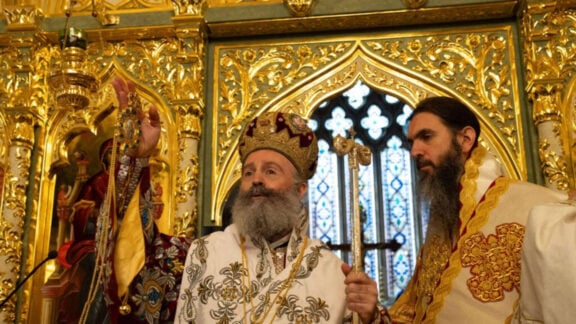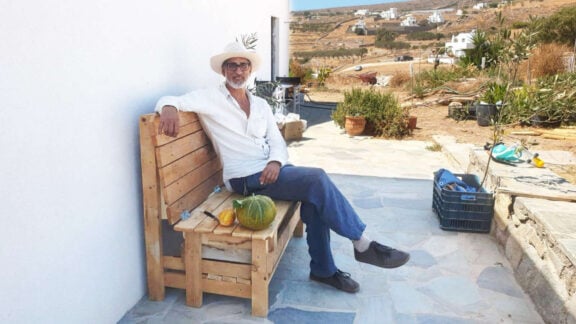In Greece, we call New Year’s Πρωτοχρονιά or αρχιχρονιά, which mean the first day of the year.
In most countries, the first of the new year is established as an official holiday and is celebrated by all.
According to the Gregorian calendar followed by the western world today, New Year’s day is January 1st, though it is not the same with all countries as many have different customs.
The Christian world considers the first day of January to be the first day of the year because that was the so-called day of Jesus’ circumcision.
Greek New Year
The new year is one of the biggest celebrations in Greece, with children singing New Year’s Carols on December 31st from early in the morning until noon, vising people’s houses and asking “Να τα πούμε;” and waiting for someone to answer “Να τα πείτε” before singing.
People typically gather with their relatives on New Year’s Eve to exchange gifts and eat all together, and in the evening cut the standard “Βασιλόπιτα”.
Greek Christmas is celebrated traditionally on January 1st, meaning that parents leave the gifts under the tree to be found on that morning.
Greeks typically eat pork for New Year’s, just like at Christmas time, and they also celebrate the namedays of people called Βασίλειος, η Βασιλεία, ο Βασιλικός, η Βασιλική and more.
There is the custom of breaking a pomegranate on New Year’s morning, with the head of the house carrying the fruit, ringing the front (not opening it themselves) so as to enter the house and conduct the podariko, with the pomegranate in hand.
Using their right hand, they throw the pomegranate at the front door forcefully enough to break it and have the seeds spread everywhere, at the same time saying “με υγεία, ευτυχία και χαρά το νέο έτος κι όσες ρώγες έχει το ρόδι, τόσες λίρες να έχει η τσέπη μας όλη τη χρονιά”.
Chinese New Year
The People’s Republic of China officially uses the Gregorian calendar like Western countries, though their New Year does not coincide with January 1st.
Rather, it is celebrated on different dates every year, since it is still based today on the ancient Chinese calendar which has its roots deep in the past when, according to tradition, it was invented and established by the Chinese Emperor Huangdi in 2637 BCE.
Like many other calendars of the world, the Chinese one is a combination of a solar and lunar calendar and is based at least in part on the phases of the Moon, a monthly phenomenon that is evident to all.
According to this calendar, a regular year has 12 lunar months and lasts from 353-355 days, while a leap year has 13 lunar months and lasts from 383-385 days.
Using this as the basis for its calendar, Chinese New year is celebrated on different dates that repeat over a 60-year period, each year being named after an animal.
Thus, the New Year in 2005 was celebrated on February 9 (year 4703 or year of the rooster), while in 2006 it was celebrated on January 29 (year 4704 or year of the dog) and so on.

Muslim New Year
In the case of the Arab-Muslim calendar, which is also lunar with a duration of 354 days, no extra month is ever added, with the result being that the various Muslim religious holidays moving throughout the seasons.
This fact causes the calendar to start 10-12 days earlier than the previous one in relation to the solar year.
The Muslim New Year is always the first day of the month which they call “Muharram”.
The Muslims start counting their years from the year of the “Hijirah”, that is July 16, 622 CE in the Julian calendar.
This day is the conventional day of Muhammad’s departure from Mecca to the neighbouring city of Medina to escape a conspiracy against him.
Japanese New Year
The Japanese calendar was similar to the Chinese and was divided into 24 fortnightly periods and linked to their agricultural work.
From 1873, however, Japan introduced the Gregorian calendar with a different dating that continues from 660 BCE.
In Japan, the New Year is celebrated after 108 bells. According to tradition, each of these hits destroys one of a person’s disadvantages.
In the first minutes of the new year, the Japanese laugh, which, in their opinion, is the key to a successful year.
The house is also decorated with bamboo, which is a symbol of eternity and faithfulness.
At dawn, the Japanese leave their homes to meet the dawn and under the first rays of the New year sun, they congratulate each other and give gifts.
The Japanese celebrate the new year with new clothes.
Hatsumode (a shrine visit) is usually held on the first day of the new year wherein people pray to the gods for health and prosperity in the coming year.

Bulgaria
In Bulgaria, loved ones, friends and relatives gather together for a meal and in all houses the lights go out for three minutes.
At this time, those gathered around the table kiss each other and no one says who they kissed.
These New Year’s kisses are protected from the darkness of the New Year.
Italy
On New Year’s Eve in Italy, old things are thrown out the window and are replaced by new ones.
Italians pay a lot of attention to who they meet on New Year’s Day, with it considered undesirable to see a clergyman or child, and it considered to be a sign of success to see an old hunchbacked grandfather.
Denmark
At midnight, the Danes put sweet rice porridge with it containing as a surprise walnuts or almonds.
This tradition especially appeals to unmarried girls who, if they find a nut, they will supposedly get married.
For married people, finding a nut promises simply a good year.
Buddhist New Year
Many peoples in Southeast Asia use the lunisolar Buddhist calendar of 12 months with 29 or 30 days, with a leap month of 30 days added at regular intervals. In these cases, the dating changes here as well.

Old Calendarists
In addition to the Christians who follow the Gregorian calendar, there also the so-called Old Calendarists that celebrate the New Year 13 days later on January 14, following the older Julian calendar instead.
The Julian calendar in terms of religious holidays is followed today by all Patriarchates and all Eastern Orthodox Churches except the Church of Greece, which in February 1924 decided to use the Gregorian calendar for religious holidays.
The exception to this are movable holidays that are based on the Easter holiday, which continues to be calculated based on the Julian calendar and the lunar cycle of Meton.









